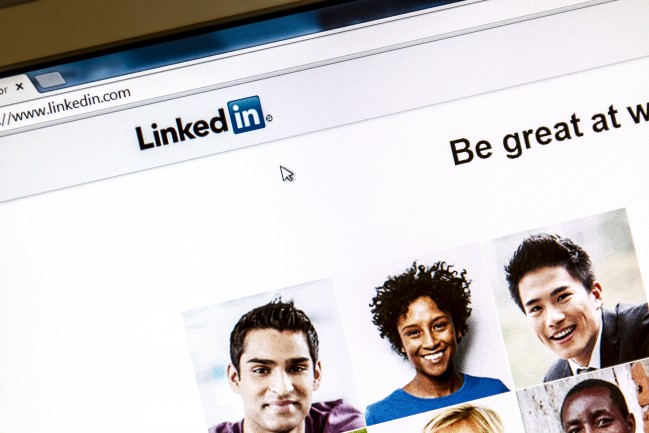

When it comes to advertising, not all social networks are created equal.
Although Facebook still remains the most popular, all-purpose place for people to gather online, its ad platform isn’t ideal for every business. Specifically, B2Bs have a hard time getting their message heard among the noise of Buzzfeed shares and birthday messages. In fact, in a recent study, Facebook ranked third among social networks for B2Bs.
LinkedIn, however, continues to dominate the list.
For anyone who’s on LinkedIn, this may not come as a surprise, since the networking site for professionals has 260 million users looking to connect with each other.
Curiously, though, its advertising platform is similar to Facebook’s. Your company can create image or video-based ads to show up in different areas of the page, and like its older, more popular social network-cousin, you can make sponsored posts that will appear in people’s news feed.
If you want to give your brand a lift or even improve sales, LinkedIn ads are a great strategy. Here are a few tips for getting started.
Write clear copy
After you’ve chosen a specific name for your particular ad, and selected if you want it to feature video or simply be text-based, it’s time to write the copy. If you’re struggling, figure out where you want to direct people when they click on your ad. In other words, what are you offering? A landing page with a newsletter subscription form should advertise accordingly in simple, clear terms.
Between your headline (25 characters) and body text (75 characters), you’ll have to entice people to click. Including a question in the headline that’s relevant to your industry and demographic is a good way to get people’s attention.
As HubSpot suggests, try creating a different ad for each of your buyer personas. For example, if your business caters in part to internet marketers, consider addressing them in your headline.
Choose a compelling (and small) image
Perhaps one of the drawbacks of LinkedIn ads is the image size. Unlike Facebook’s sponsored posts or the display ads on Google+, both of which allow brands to have big, full attention-grabbing pictures, LinkedIn limits your ad to 50×50 pixels. In a way, this does level the playing field for smaller businesses that can’t afford designers, or access to photo stocks.
But no matter the size of your company, the reduced image capability means you have to be extra judicious when selecting your photo. Like the copy, make it simple and bold. You might even consider using your logo, if it lends itself well.
Include a CTA
A good rule of thumb for any internet ad with limited copy is to have a clear call to action (CTA). Even really persuasive copy won’t earn clicks without an obvious directive (“Sign up!”, “Click here”, “Advertise with us.”). Can’t decide which CTA is best? One of the advantages of advertising on LinkedIn is that you get up to 15 versions of the same ad campaign. You can tweak the copy to appeal to different demographics, and to test the strength of different CTAs.
Target your audience
Advertising blindly might be good for brand awareness (emphasis on “might”), but most companies would agree that that’s a risky, costly proposition. Luckily, LinkedIn lets you target your ad. Choosing from location to company to job title and more, you can optimize it to make sure that it’s seen by the right people.
For example, you can direct it towards professionals who work for a specific business, or you can go broader and target people form a certain industry.
Additionally, take advantage of the social network’s lead collection feature. For your ad, you can choose to include a check-able box where people can indicate whether or not they’d like to hear more from you about your offer. You can then follow up with them over LinkedIn.
Decide what kind of campaign you’re running
A common payment structure for internet advertising is cost-per-click (CPC) or cost-per-1,000 impressions (CPM). LinkedIn is no different. CPC is pretty much what it sounds like. You’ll be charged every time a user clicks on your ad. You decide what you’re going to pay based on a bidding system. LinkedIn suggests a minimum bid based on the competition of your ad and industry.
Your final bid represents the most you’ll be charged, but you may actually be charged less depending on the current rate, which fluctuates. If your goal is to get clicks to your landing page or website, CPC is the way to go.
For CPM campaigns, you’re charged for every 1,000 displays of your ad. This is a good strategy if you’re trying to boost brand awareness in your industry.
The minimum budget for a campaign is $10 per day, while the minimum spend for a CPC bid is $2 / click.
Track it
A good success rate on LinkedIn ads is .03%, which may affect whether you want to aim for clicks or impressions. Using their basic analytics as well as any Google tracking you have, check in often to see how your campaigns are performing. Fortunately, you can edit the poor performers to improve their copy and CTAs, or you can pause them altogether and instead re-direct your funds to promote the super stars.
If success rates aren’t immediately clear, do a little math. Calculate your average spend per day for the previous week. Then compare it to your daily budget. If those numbers are similar, you might consider increasing your daily amount to improve the ads’ performances.
The post Want to Boost Your LinkedIn Presence? Try Ads first appeared on Web Design & Digital Marketing Tips.
